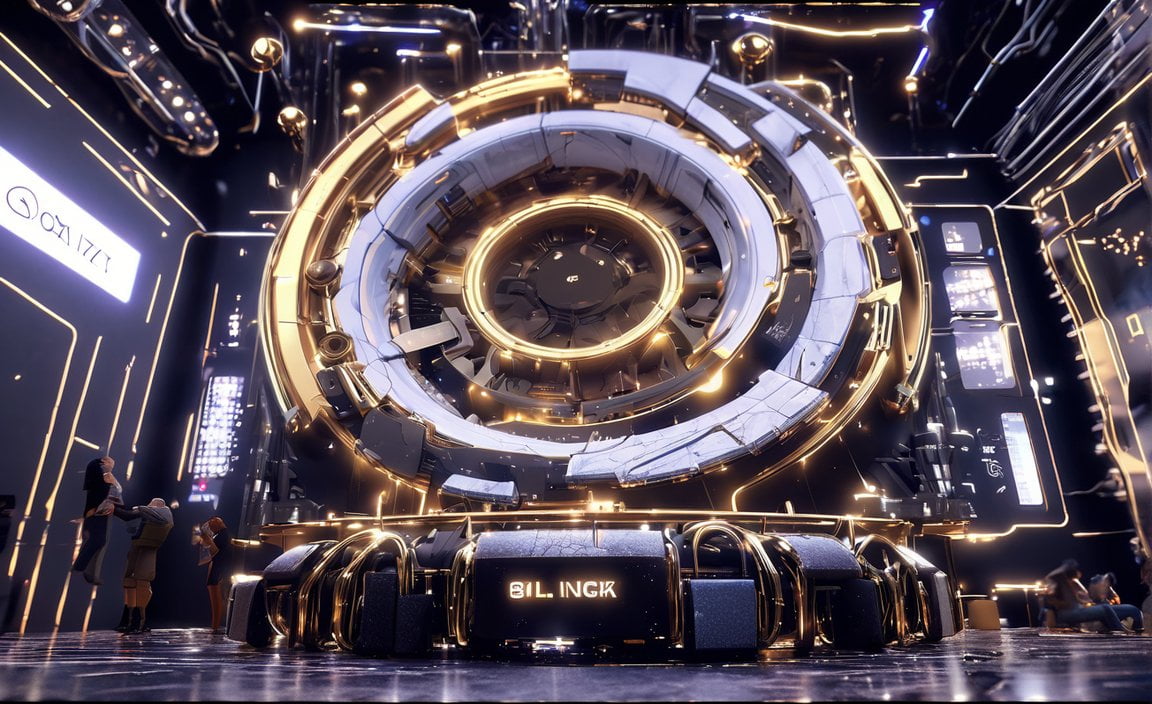Get ready to dive into the fascinating world of technology with our article, “Fascinating Tech Facts: Exploring the Intriguing World of Technology.” From mind-boggling advancements to quirky trivia, we’ll take you on a journey through some of the most interesting facts about technology. Whether you’re a tech enthusiast or simply curious about how the world around us is constantly evolving, this article is sure to captivate your imagination. So, let’s unravel the mysteries and discover the intriguing secrets of the tech world together!

Key Takeaways:
- The Firefox browser logo was originally a red panda, not a fox.
- The first Apple logo depicted Sir Isaac Newton sitting beneath a tree with an apple about to fall on his head.
- Google rents out goats to eat grass at their headquarters in Mountain View.
- The word “robot” comes from the Czech word “robota,” which means forced labor or work.
- The first-ever VCR was as big as a piano.
- The world’s first website was created by British scientist Tim Berners-Lee in 1989.
- Motorola released the first mobile phone.
- Riken Research Lab and Fujitsu’s Fugaku supercomputer is the most powerful in the world.
- The first computer mouse was built by colleagues at SRI.
- IT professionals also experience stress related to technology.
- The term “bug” in computer systems was named after a literal bug found in a computer.
- The creator of Bitcoin remains unknown.
- CarMax, the largest used-car retailer, was founded by Circuit City.
- The QWERTY keyboard layout can slow down typing speed.
Interesting Facts About Technology
Technology is constantly evolving, bringing new discoveries and innovations that have revolutionized the way we live, work, and connect with the world around us. In this article, we will explore some fascinating facts about technology that will widen your perspective and leave you in awe of its wonders.
1. The Firefox logo was originally a red panda, not a fox.
When you think of the Firefox browser, you probably envision a fox. However, the original logo design featured a red panda. The creators chose the name “Firefox” as a tribute to the red panda’s fiery red fur and its resemblance to the mythical creature, which is said to possess the ability to shape-shift.
2. The first Apple logo featured Sir Isaac Newton sitting beneath a tree.
Before the iconic bitten apple logo we know today, Apple’s first logo depicted Sir Isaac Newton sitting beneath a tree with an apple about to fall on his head. The logo symbolized Apple’s innovative spirit and desire to challenge conventional thinking, drawing inspiration from Newton’s groundbreaking discovery of the laws of gravity.
3. Google uses goats to mow the grass at their headquarters.
Google is known for its unconventional workplace practices, and one of them involves renting out goats to maintain the grass at their headquarters in Mountain View. These eco-friendly “lawnmowers” provide a sustainable and natural solution to keeping the grounds tidy while reducing carbon emissions.
4. The word “robot” originated from the Czech word “robota”.
The term “robot” derives from the Czech word “robota,” which means forced labor or work. It was first introduced by Czech playwright Karel Čapek in his play “R.U.R.” (Rossum’s Universal Robots) in 1920. The play explored the idea of artificial beings designed to carry out laborious tasks, thus giving birth to the concept of robots as we know them today.
5. The first-ever VCR was as big as a piano.
In the early days of home video recording, the first VCRs (Video Cassette Recorders) were massive in size, resembling a bulky piece of furniture rather than a sleek device. These pioneering VCRs were as large as a piano and weighed a staggering amount. Thankfully, technological advancements have made our modern-day devices much more compact and portable.
6. The first website ever was created by British scientist Tim Berners-Lee.
The birth of the World Wide Web can be credited to British scientist Tim Berners-Lee. In 1989, he created the first-ever website, laying the foundation for the online world we know today. This monumental achievement paved the way for global connectivity and transformed the way information is shared and accessed worldwide.
7. Motorola released the world’s first mobile phone.
Motorola holds the distinction of releasing the world’s first mobile phone, named the Motorola DynaTAC 8000X. This groundbreaking device, introduced in 1983, was bulky, expensive, and had limited functionality compared to today’s smartphones. Nevertheless, it marked the beginning of a revolution in communication technology, ultimately leading to the widespread use of mobile devices around the globe.
8. Riken Research Lab and Fujitsu’s Fugaku supercomputer is the most powerful in the world.
The Riken Research Lab and Fujitsu jointly developed the Fugaku supercomputer, which currently holds the title of the world’s most powerful supercomputer. This groundbreaking machine is capable of incredible computational power, enabling scientists and researchers to tackle complex problems in various fields, such as climate modeling, drug discovery, and astrophysics.
9. The first computer mouse was built by colleagues at SRI.
The computer mouse, a ubiquitous peripheral device that revolutionized user interaction with computers, was invented by colleagues at Stanford Research Institute (SRI). Doug Engelbart is often credited with its invention in the 1960s, as his prototype became the basis for the modern mouse we know today. This invention created a new standard for navigating digital interfaces and continues to shape user experiences.
10. IT professionals also experience stress related to technology.
While technology offers countless benefits and opportunities, it is not without its challenges. IT professionals, responsible for ensuring the smooth functioning of technological systems, often experience high levels of stress. The ever-increasing complexity of technology and the expectations placed upon them can lead to burnout and other mental health issues. Taking care of our technology professionals is crucial for maintaining a healthy and productive tech ecosystem.
11. The term “bug” was named after a literal insect found in a computer.
The term “bug” is commonly used in the technology industry to refer to an error or glitch in a system. The origin of this term can be traced back to the early days of computing when a moth was discovered stuck in a relay in the Mark II computer. The engineers at Harvard termed it a “bug,” and thus the phrase entered the technology lexicon.
12. The creator of Bitcoin remains a mystery.
Bitcoin, the world’s first decentralized digital currency, was introduced by an individual, or group of individuals, using the pseudonym “Satoshi Nakamoto.” Despite numerous speculations and investigations, the true identity of Bitcoin’s creator remains a mystery, adding an air of intrigue and mystique to the cryptocurrency’s origin.
13. CarMax, the largest used-car retailer, was founded by Circuit City.
CarMax, a well-known used-car retailer, was actually founded by Circuit City, a former electronics retailer. Recognizing the potential in the used-car market, Circuit City established CarMax as a separate entity in 1993. Today, CarMax has become the largest retailer of used cars, with a wide selection and streamlined buying process.
14. The QWERTY keyboard can slow down typing speed.
The QWERTY keyboard layout, which is widely used in modern computers, was designed to prevent mechanical typewriters from jamming. However, this layout can actually slow down typing speed and efficiency due to the position of certain keys. Alternative keyboard layouts, such as the Dvorak Simplified Keyboard, aim to address this issue by optimizing key placement for faster and more comfortable typing.
These captivating and intriguing facts illuminate the world of technology, showcasing the ingenuity, creativity, and endless possibilities that technology brings. As we continue to embrace technological advancements, let us appreciate the fascinating stories and achievements that have shaped the digital landscape we know today.
Did you know that crocodiles are surprisingly smart? Find out just how intelligent these ancient reptiles are in our article on how smart are crocodiles!
If you’re curious about the incredible wonders of the universe, be sure to check out our fascinating planet fact file. Discover mind-blowing facts about the different planets that make up our solar system.
Smartphones have revolutionized the way we live, providing easy access to information, communication, and entertainment.
Smartphones have transformed our lives in unimaginable ways. These pocket-sized devices have become an integral part of our daily routines, offering seamless access to information, communication, and entertainment. Let’s delve into some intriguing facts about how smartphones have revolutionized our world.
Smartphones: The Modern Communication Hub
Smartphones have turned communication into a breeze. With a plethora of options available at our fingertips, we can connect with others anytime, anywhere. Whether it’s making voice and video calls, sending texts, or emailing, smartphones provide an array of communication avenues. This level of connectivity was unimaginable just a few years ago, making smartphones an indispensable tool in our lives.
The Swiss Army Knife of Technology
Smartphones are no longer just communication devices; they have evolved into multifunctional gadgets that cater to our diverse needs. From navigation and taxi booking to comparing reviews and prices, watching movies, listening to music, playing games, and participating in social media – smartphones have consolidated various functions into one device. They have truly become the “human snails carrying our homes in our pockets.”
The Impact on Society and Concerns
While smartphones have undoubtedly revolutionized our lives, there are concerns about their cost and impact on our daily routines. Studies have shown that excessive smartphone use can be distracting and have negative effects on our productivity, mental health, and overall well-being. Researchers have delved into how smartphones are used in communities worldwide, studying their influence on social dynamics, relationships, and even educational outcomes.
The Technological Revolution of the 21st Century
The 21st century has witnessed a technological revolution that has reshaped societies across the globe. From the burst of the dotcom bubble in 2000 to the advancement of smartphones and social media, technology has brought unprecedented changes. Smartphones, in particular, have been recognized as the most disruptive technology of recent decades, seamlessly integrating into every aspect of our lives and transforming the way we interact with the world.
Key Takeaways:
- Smartphones have revolutionized communication, providing convenient access to voice and video calls, texting, and emailing.
- These devices cater to a wide range of needs, from navigation and booking services to entertainment and social media.
- Concerns exist regarding the impact of excessive smartphone use on productivity, mental health, and overall well-being.
- The technological revolution of the 21st century, including the rise of smartphones, has reshaped societies worldwide.
Sources:
1. National Geographic
2. The World Economic Forum
Artificial Intelligence (AI): Definition, Examples, and Types
Artificial intelligence (AI) is a rapidly growing field in technology, with applications ranging from virtual assistants to autonomous vehicles. In this article, we will explore the intriguing world of AI, its definition, examples, and types.
Definition of Artificial Intelligence
Artificial Intelligence (AI) refers to the ability of a digital computer or computer-controlled robot to perform tasks that would typically require human intelligence. It enables machines to perform speech recognition, visual perception, decision-making, and problem-solving. AI aims to replicate human cognitive processes and develop intelligent machines that can perform complex tasks autonomously.
According to an article on Britannica,¹ AI can be broadly categorized into two main branches: narrow AI and general AI. Narrow AI refers to AI systems designed to perform specific tasks and excel in performing those tasks. General AI, on the other hand, aims to create machines with human-like intelligence that can understand, learn, and perform any intellectual task.
Examples of Artificial Intelligence
AI has made significant advancements in various industries, revolutionizing the world. Let’s explore a few notable examples:
- Self-Driving Cars: Self-driving cars are one of the most well-known applications of AI. Using AI algorithms, these vehicles navigate, recognize obstacles, and make decisions while driving. They aim to improve road safety and replace human drivers.
- Virtual Personal Assistants: Virtual personal assistants, such as Siri, Alexa, and Google Assistant, use AI technology to understand natural language and perform tasks based on user commands. They can provide relevant responses, schedule appointments, play music, and more.²
Types of Artificial Intelligence
Within the field of AI, there are different types or categories of AI systems. Let’s look at a few common types:
- Machine Learning: Machine learning is a subset of AI that focuses on developing algorithms that can learn from data and make predictions or decisions. AI systems are trained with large datasets to identify patterns and gain insights.
- Natural Language Processing (NLP): NLP deals with the interaction between computers and human language. It enables machines to understand, interpret, and generate human language, facilitating tasks like speech recognition, language translation, and sentiment analysis.³
Key Takeaways:
- AI refers to the ability of machines to perform tasks that typically require human intelligence.
- Narrow AI focuses on specific tasks, while general AI aims to replicate human-like intelligence.
- Examples of AI include self-driving cars and virtual personal assistants.
- Machine learning and natural language processing are common types of AI.
By exploring the definition, examples, and types of AI, we can gain a better understanding of this rapidly growing field in technology.
Virtual Reality (VR) Technology: Exploring Immersive Experiences
Virtual reality (VR) technology allows users to immerse themselves in a simulated environment, opening up new possibilities for entertainment and training. With VR, users can step into a completely different world and interact with computer-generated environments, creating a realistic and immersive experience.
VR technology focuses on providing an experiential interface, allowing users to physically look around within the virtual environment and perform specific actions. It goes beyond traditional observational experiences and enables users to engage in a more interactive and engaging manner.
The term “virtual reality” was coined by Jaron Lanier in 1987, but the concept of creating imaginative worlds and fictional spaces has intrigued artists, performers, and entertainers for much longer. VR technology has revolutionized various industries, including aviation, by enabling training for commercial pilots and aircraft inspection using realistic cockpits and VR simulations.
One of the significant impacts of VR technology is its potential in the field of healthcare. It is being used in the treatment of Post-Traumatic Stress Disorder (PTSD), allowing patients to relive traumatic experiences in a controlled environment for therapeutic purposes. The immersive nature of VR provides deeper immersion and the ability to share unbounded spaces and experiences with others.
VR technology finds applications beyond healthcare as well, such as in gaming, movies, and storytelling. By using VR headsets or head-mounted displays, users can dive into exciting game worlds, become part of cinematic experiences, or explore interactive narratives. The possibilities for immersive entertainment seem endless with VR.
Key Takeaways:
- Virtual reality (VR) technology allows users to immerse themselves in simulated environments, providing a realistic and engaging experience.
- VR focuses on experiential interfaces, enabling users to physically explore and interact within the virtual environment.
- VR has revolutionized industries like aviation, where it is used for pilot training and aircraft inspection.
- The potential of VR in healthcare is being explored, particularly in the treatment of PTSD.
- In entertainment, VR is used to create immersive gaming experiences, cinematic adventures, and interactive storytelling.
Sources:
– Virtual Reality Definition – Britannica
– Virtual Reality Technology and Its Impact – PMC – NCBI

FAQ
Q1: What was the first-ever VCR like in terms of size?
A1: The first-ever VCR was the size of a piano.
Q2: Who created the first website ever?
A2: The first website ever was created by British scientist Tim Berners-Lee in 1989.
Q3: Which company released the world’s first mobile phone?
A3: Motorola released the world’s first mobile phone.
Q4: What is the most powerful supercomputer in the world?
A4: The Riken Research Lab and Fujitsu’s Fugaku supercomputer is currently the most powerful supercomputer in the world.
Q5: What was the first computer mouse created by?
A5: The first computer mouse was built by colleagues at SRI (Stanford Research Institute).
- Red Cloud, NE: Discover Willa Cather’s Legacy - April 11, 2025
- Remember Old Social Media Sites? Their Rise and Fall - April 11, 2025
- How many days till Feb 3?Accurate Countdowns & Tools - April 11, 2025
















